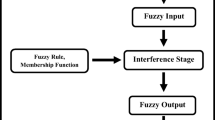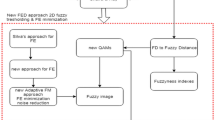Abstract
Texture is one of the most used low-level features for image analysis and, in addition, one of the most difficult to characterize. Although there is not an accurate definition for the concept of texture, it is usual for humans to describe visual textures according to some perceptual properties like coarseness, directionality, contrast, line-likeness or regularity. In this paper, we propose to model texture on the basis of its perceptual properties. To do this, fuzzy sets defined on the domain of some of the most representative measures of each property are employed. This approach achieves a double objective: first, to obtain models that allow to represent the imprecision related to texture properties, and second, to identify the most appropriate measure for each of these properties. In order to define the fuzzy models, parametric membership functions are proposed, where the corresponding parameters are obtained by learning a functional relationship between the computational values given by the measure and the human perception of the corresponding property. The performance of each fuzzy set is analyzed and checked with the human assessments, and a ranking of measures is obtained according to their ability to represent the perception of the property, allowing to identify the most suitable measure. In order to explain the proposed methodology, we focus our study on coarseness, contrast and directionality, that are considered the three most important texture properties.










Similar content being viewed by others
Notes
Let us remark that “coarseness” and “fineness” are opposite but related textural concepts. The advantage of modelling the concept of fineness is that the maximum presence of this property in the image is delimited by the size of pixel.
To simplify the notation, as it is usual in the scope of fuzzy sets, we will use the same notation \(\mathcal {T}^p_k\) for the fuzzy set and for the membership function that defines it.
As mentioned in Sect. 3, the measures used in this study are not size dependent. Therefore, the models obtained by means of the fitting process don’t depend on the window size. Sub-images smaller than \(32\times 32\) are not considered because they would break texture primitives.
Note that this function is defined for measures that decrease according to the perception of fineness. For those that increase, the function needs to be changed appropriately, i.e. it takes the value \(0\) for \(x<\beta \), it takes the value \(1\) for \(x>\alpha \), and the polynomial function is computed for \(\beta \le x \le \alpha \).
Actually, note that an ideal mapping would not be exactly as shown in the figure, because pixels near the boundary of different textures would have an intermediate fineness value of both textures.
Actually, note that an ideal mapping would not be exactly as shown in the figure, because the contrast degree in the border area between different textures would depend on the contrast of each texture as well as the contrast between them.
Actually, note that an ideal mapping would not be exactly as shown in the figure, because the directionality degree of the pixels near the boundary of adjacent textures would decrease as the orientation of both texture primitives is different.
References
Abbadeni N, Ziou N, Wang DS (2000) Autocovariance-based perceptual textural features corresponding to human visual perception. In: Proceedings of 15th international conference on pattern recognition, vol 3, pp 901–904
Aboulmagd H, El-Gayar N, Onsi H (2008) A new approach in content-based image retrieval using fuzzy. Telecomm Syst 40(1):55–66
Amadasun M, King R (1989) Textural features corresponding to textural properties. IEEE Trans Syst Man Cybernet 19(5):1264–1274
Arivazhagan S, Ganesan L (2003) Texture classification using wavelet transform. Pat Recogn Lett 24(9–10):1513–1521
Arivazhagan S, Ganesan L. Padam Priyal S (2006) Texture classification using Gabor wavelets based rotation invariant features. Pat Recogn Lett 27(16):1976–1982
Battiato S, Gallo G, Nicotra S (2003) Perceptive visual texture classification and retrieval. In: Proceedings of international conference on image analysis and processing, pp 524–529
Beaton AE, Tukey JW (1974) The fitting of power series, meaning polynomials, illustrated on band-spectroscopic data. Technometrics 16:147–185
Brodatz P (1966) Textures: a photographic album for artists and designers. Dover Publishing Co., New York
Celik T, Tjahjadi T (2011) Bayesian texture classification and retrieval based on multiscale feature vector. Pat Recogn Lett 32(2):159–167
Chamorro-Martínez J, Martínez-Jiménez P (2009) A comparative study of texture coarseness measures. In: IEEE International Conference on Image Processing, pp 1337–1340
Choy SK, Tong CS (2010) Statistical wavelet subband characterization based on generalized gamma density and its application in texture retrieval. IEEE Trans Image Proc 19(2):281–289
Galloway MM (1975) Texture analysis using gray level run lengths. Comp Graph Image Proc 4:172–179
Han J, Ma K-K (2007) Rotation-invariant and scale-invariant Gabor features for texture image retrieval. Image Vision Comput 25(9):1474–1481
Haralick RM (1979) Statistical and structural approaches to texture. Proc IEEE 67(5):786–804
Hiremath PS, Shivashankar S (2006) Wavelet based features for texture classification. ICGST Intern J Graph Vision Image Proc 6(3):55–58
Jain AK, Farrokhnia F (1991) Unsupervised texture segmentation using Gabor filters. Pat Recogn 24(12):1167–1186
Kim SI, Choi KC, Lee DS (1991) Texture classification using run difference matrix. In: Proceedings of IEEE 1991 ultrasonics symposium, vol 2, pp1097–1100
Laine A, Fan J (1993) Texture classification by wavelet packet signatures. IEEE Trans Pat Anal Mach Intell 15(11):1186–1191
Li M, Staunton RC (2008) Optimum Gabor filter design and local binary patterns for texture segmentation. Pat Recogn Lett 29(5):664–672
Lin HC, Chiu CY, Yang SN (2003) Finding textures by textual descriptions, visual examples, and relevance feedbacks. Pat Recogn Lett 24(14):2255–2267
Lin WT, Lin CH, Wu TH, Chan YK(2010) Image segmentation using the k-means algorithm for texture features. In: Proceedings of international conference on computer, electrical, and systems science, and engineering (ICCESSE), pp 26–28
Ma WY, Manjunath BS (1995) A comparison of wavelet transform features for texture image annotation. IEEE Intern Conf Image Proc 2:256–259
Maeda J, Kawano A, Yamauchi S, Suzuki Y, Marçal ARS, Mendonça T (2008) Perceptual image segmentation using fuzzy-based hierarchical algorithm and its application to dermoscopy images. In: Proceedings of the IEEE conference on soft computing in industrial applications, pp 66–71
Mandelbrot BB (1982) The fractal geometry of nature. Freeman, San Francisco
Manjunath BS, Ohm J-R, Vasudevan VV, Yamada A (2001) Color and texture descriptors. Circuits and systems for video technology. IEE Trans 11(6):703–715
Manjunath BS (2002) Introduction to MPEG-7: Multimedia content description interface. Wiley, New York
Newsam SD, Kammath C (2004) Retrieval using texture features in high resolution multi-spectral satellite imagery. SPIE conference on data mining and knowledge discovery: theory, tools, and technology VI, vol 5433, pp 21–32
Niblack W, Barber R, Equitz W, Flickner M, Glasman EH, Petkovic D, Yanker P, Faloutsos C, Taubin G (1993) The QBIC project: Querying images by content, using color, texture, and shape. In: Proceedings of Storage and Retrieval for Image and Video Databases (SPIE), pp 173–187
Peleg S, Naor J, Hartley R, Avnir D (1984) Multiple resolution texture analysis and classification. IEEE Trans Pat Anal Mach Intell 4:518–523
Pietikäinen M, Hadid A, Zhao G, Ahonen T (2011) Texture classification and segmentation. In: Computer vision using local binary patterns, computational imaging and vision, vol 40. Springer, London, pp 69–79.
Portilla J, Simoncelli EP (2000) A parametric texture model based on joint statistics of complex wavelet coefficients. Intern J Comp Vision 40:49–71
Rao AR, Lohse GL (1993) Identifying high level features of texture perception. Graph Models Image Proc 55(3):218–233
Russ JC (1999) The image processing handbook, 3rd edn. CRC Press and IEEE Press, Boca Raton
Scarpa G, Gaetano R, Haindl M, Zerubia J (2009) Hierarchical multiple Markov chain model for unsupervised texture segmentation. IEEE Trans Image Proc 18(8):1830–1843
Sun C, Wee WG (1983) Neighboring gray level dependence matrix for texture classification. Comput Vision Graph Image Proc 23:341–352
Tamura H, Mori S, Yamawaki T (1978) Textural features corresponding to visual perception. IEEE Trans Syst Man Cybernet 8:460–473
Verma B, Kulkarni S (2004) A fuzzy-neural approach for interpretation and fusion of colour and texture features for CBIR systems. Appl Soft Comput 5(1):119–130
Weszka JS, Dyer CR, Rosenfeld A (1976) A comparative study of texture measures for terrain classification. IEEE Trans SMC 6:269–285
Wu P, Ro YM, Won CS, Choi Y (2001) Texture descriptors in MPEG-7. In: Proceedings of the 9th International Conference on Computer Analysis of Images and Patterns, CAIP ’01. Springer-Verlag, Berlin, pp 21–28
Yager RR (1988) On ordered weighted averaging aggregation operators in multicriteria decisionmaking. IEEE Trans SMC 18(1):183–190
Yoshida H, Casalino DD, Keserci B, Coskun A, Ozturk O, Savranlar A (2003) Wavelet-packet-based texture analysis for differentiation between benign and malignant liver tumours in ultrasound images. Phys Med Biol 48:3735–3753
Zhang D, Wong A, Indrawan M, Lu G (2000) Content-based image retrieval using Gabor texture features. In: IEEE pacific-rim conference on multimedia, pp 392–395
Acknowledgments
This work has been partially supported by the Government of Spain under Research Program Consolider Ingenio 2010: Multimodal Interaction in Pattern Recognition and Computer Vision (CSD2007-00018) and under the TIN2009-08296 project. We also would like to thank Dr. Daniel Sánchez for his valuable assistance in the field of fuzzy logic, as well as Elena Galán-Perales for her contribution in the human assessment collection.
Author information
Authors and Affiliations
Corresponding author
Additional information
Communicated by V. Loia.
Rights and permissions
About this article
Cite this article
Chamorro-Martínez, J., Martínez-Jiménez, P.M., Soto-Hidalgo, J.M. et al. Perception-based fuzzy sets for visual texture modelling. Soft Comput 18, 2485–2499 (2014). https://doi.org/10.1007/s00500-014-1226-8
Published:
Issue Date:
DOI: https://doi.org/10.1007/s00500-014-1226-8




